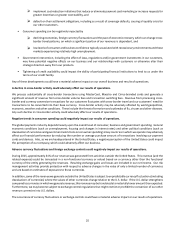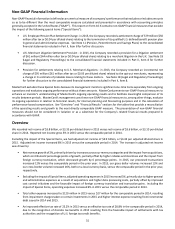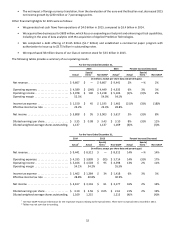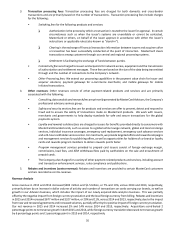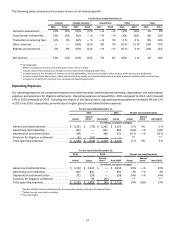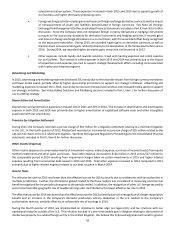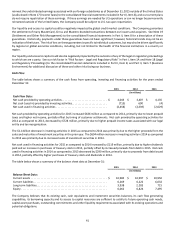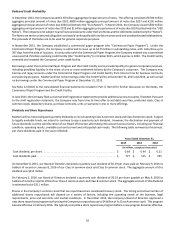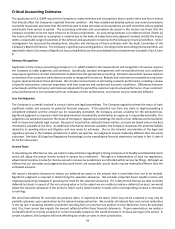MasterCard 2015 Annual Report Download - page 40
Download and view the complete annual report
Please find page 40 of the 2015 MasterCard annual report below. You can navigate through the pages in the report by either clicking on the pages listed below, or by using the keyword search tool below to find specific information within the annual report.34
most non-European regions, GDV is calculated based on local currency spending volume converted to U.S. dollars using average
exchange rates for the period. In Europe, GEV is calculated based on local currency spending volume converted to euros using
average exchange rates for the period. As a result, our domestic assessments, cross-border volume fees and volume related
rebates and incentives are impacted by the strengthening or weakening of the U.S. dollar versus primarily non-European local
currencies and the strengthening or weakening of the euro versus primarily European local currencies. For example, our billing
in Australia is in U.S. dollar, however, consumer spend in Australia is in Australian dollar. The foreign currency transactional
impact of converting Australian dollars to our billing currency in U.S. dollars will have an impact on the revenue generated. The
strengthening or weakening of the U.S. dollar is evident when GDV growth on a U.S. dollar converted basis is compared to GDV
growth on a local currency basis. In 2015, GDV on a U.S. dollar converted basis increased 1% versus GDV growth on a local
currency basis of 13%. In 2014, GDV on a U.S. dollar converted basis increased 10% versus GDV growth on a local currency basis
of 13%. The Company attempts to manage these foreign currency exposures through its foreign exchange risk management
activities, which are discussed further in Note 20 (Foreign Exchange Risk Management) to the consolidated financial statements
included in Part II, Item 8.
The Company generates revenue and has financial assets in countries at risk for currency devaluation. While these revenues
and financial assets are not material to MasterCard on a consolidated basis, they could be negatively impacted if a devaluation
of local currencies occurs relative to the U.S. dollar.
Financial Results
Revenue
Revenue Description
MasterCard’s business model involves four participants in addition to us: cardholders, merchants, issuers (the cardholders’
financial institutions) and acquirers (the merchants’ financial institutions). Our gross revenue is generated by assessing our
customers based primarily on the dollar volume of activity on the cards and other devices that carry our brands and from the
fees that we charge our customers for providing transaction processing and other payment-related products and services. Our
revenue is based upon transactional information accumulated by our systems or reported by our customers. Our primary revenue
billing currencies are the U.S. dollar, euro and Brazilian real.
The price structure for our products and services is complex and is dependent on the nature of volumes, types of transactions
and type of products and services we offer to our customers. Our net revenue can be significantly impacted by the following:
• domestic or cross-border transactions;
• signature-based or PIN-based transactions;
• geographic region or country in which the transaction occurs;
• volumes/transactions subject to tiered rates;
• processed or not processed by MasterCard;
• amount of usage of our other products or services; and
• amount of rebates and incentives provided to customers.
The Company classifies its net revenue into the following five categories:
1. Domestic assessments fees: Domestic assessments are fees charged to issuers and acquirers based primarily on
the dollar volume of activity on cards and other devices that carry our brands where the merchant country and the
issuer country are the same. Domestic assessments include items such as card assessments, which are fees charged
on the number of cards issued or assessments for specific purposes, such as acceptance development or market
development programs.
2. Cross-border volume fees: Cross-border volume fees are charged to issuers and acquirers based on the dollar
volume of activity on cards and other devices that carry our brands where the merchant country and the issuer
country are different. In general, a cross-border transaction generates higher revenue than a domestic transaction
since cross-border fees are higher than domestic fees, and in most cases also include fees for currency conversion.



